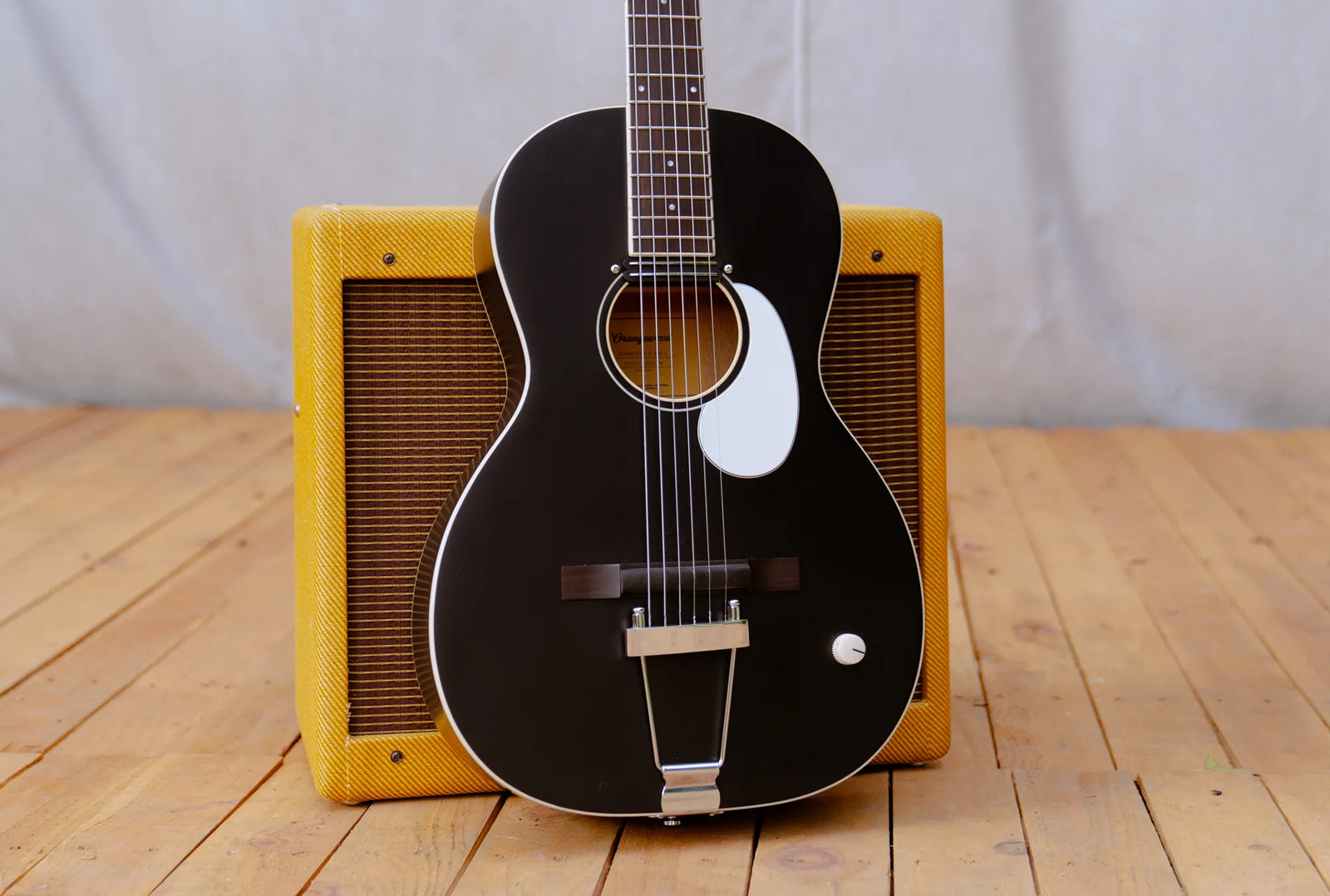
Los Angeles got a new sound — one that’s soft, dark, and dreamy.
This sound belongs to a type of muted guitar called a rubber bridge guitar. Tune in as we walk you through one of music’s coolest new sounds and how you can get it.
What’s a Rubber Bridge Guitar?
A rubber bridge guitar is a guitar that uses rubber to dampen and change its sound.
Traditional acoustic guitars create sound when strings send vibrations throughout the top of the guitar from the saddle and bridge. A rubber bridge guitar works the same way, but a piece of rubber material touches the strings to interfere with the transfer of vibrations.
People describe the raw, muted sound of a rubber bridge guitar as plunky, thumpy, round, deadened, and more. We like to think of it as dreamy and ethereal. It’s mellow-yet-articulate.
It’s a blank canvas to put your sonic signature on — one that you can explore endlessly as you add new sounds, new textures, and new ideas to your playing.

The Music of Mutes
Driven by DIY spirit and the pursuit of tone, guitarists and builders have experimented with muting for decades.
One common technique is palm muting. This is where you play with the blade of your picking hand pressed against the strings. It’s useful for getting a chugging, hard rock or metal sound when combined with distortion.
Besides playing technique, guitarists and bassists have relied on muting or altering their instruments’ tone any way they can. Imagine scrunchies and sweatbands placed near the headstock to dampen overtones. Other materials that have been used to achieve a muted, dreamy sound include leather, fabric, and cloth.
Bassist Carol Kaye, for example, was known for her muting technique, placing a piece of felt over bass strings to reduce under- and over tones.
Apart from artist-led DIY, manufacturers have released and continued to release models with built-in muting. Great examples are Fender’s Precision Bass and Jaguar models. Ernie Ball Music Man recently released their ‘70s StingRay basses that feature built-in, adjustable rubber mutes under each of the strings.
The City of Muses Today
Los Angeles is home to trend-setting indie artists who are always on the lookout for inspiration to define the next era of music. In the past few years, that sound has been marked by rubber bridge guitars.
Reuben Cox, the owner and lead luthier of the Silver Lake-based Old Style Guitar Shop (@oldstyleguitarshop), is credited with developing and popularizing rubber bridge guitars; his instruments then found their way into the hands, and records, of artists and bands including Taylor Swift, Phoebe Bridgers, Wilco, and more.
Introducing Juniper
Inspired by the innovations of luthiers and artists who trail-blazed the rubber bridge guitar sound, we wanted to develop a uniquely Orangewood take on this exciting instrument.
To bring you a modern rubber bridge sound, our team tackled many challenges during research and development. Starting with our parlor guitar platform, we developed our Juniper models to capture that old-school sound, play easily and in-tune, and be affordable.
Juniper is a modern rubber bridge guitar that combines the accessibility and durability of our Overland Collection with the vintage charm of our Highland Collection. Juniper is available in two versions: Black and Sunburst. Shop for your favorite here.
Bridging the Gap
Turning a traditional acoustic guitar into a modern rubber bridge guitar gave our team unique challenges.
First, we had to come up with a rubber bridge design that would sound right and maintain intonation. (Intonation is a guitar’s ability to play in tune.)
Much trial-and-error later, we settled on one that had the right thickness of rubber, the right surface area, and the right adjustability.

After solving for the rubber bridge itself, our Product team updated our bridge construction with additional reinforcement and added a trapeze tailpiece. All of these help maintain overall structural integrity while supporting the sound.
In a nutshell, these components make the guitar easily adjustable to your preference and sweeten the vintage vibes.

Tune Easy
To make the Juniper even easier to play, we upgraded the tuners to Grover open-gear tuners with an 18:1 gear ratio. We curated these premium tuners for their vintage look, ease-of-use, and superior tuning stability.
Be Electric
Muting the sound was only the start. After all, palm muting (a similar-but-different sound) already exists, and we wanted to push into the electric realm.
While the Juniper sounds great unplugged, it especially shines when you run it through your favorite pedals — from reverb to fuzz — to accentuate the tone.

The answer was a high-output rail pickup combined with a single cupcake-style volume knob — easy for beginners and touring pros alike. Need a primer on acoustic-electric adventures? Check out our articles A Guide to Acoustic Guitar Pedals and How To Record Guitar.
Your Juniper comes strung with Ernie Ball flatwound electric guitar strings. Chosen for their mellower, warmer tone, flatwounds emphasize the overall rubber bridge tone.
(And you may be surprised to learn that these strings are originally designed for electric guitars!)
A Jumping Off Point
We developed our Juniper models for you to enter the world of rubber bridge guitars, to be inspired, and to get you that much closer to the sounds and songs in your head.
Follow us on TikTok and YouTube for more rubber bridge insights and inspiration!






